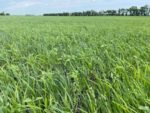Advertise Follow Us
Articles Tagged with ''forage crops''
Power of Legumes, Part 3
Five fields sampled for biological diversity and measured with the Phospholipid Fatty Acid (PFLA) test showed some interesting results.
Read More
What I've Learned from No-Tilling
No-Till Brings Challenges Surprises and New Options
Fewer field passes means this California no-tiller and dairyman can raise three forage crops per year.
Read More







